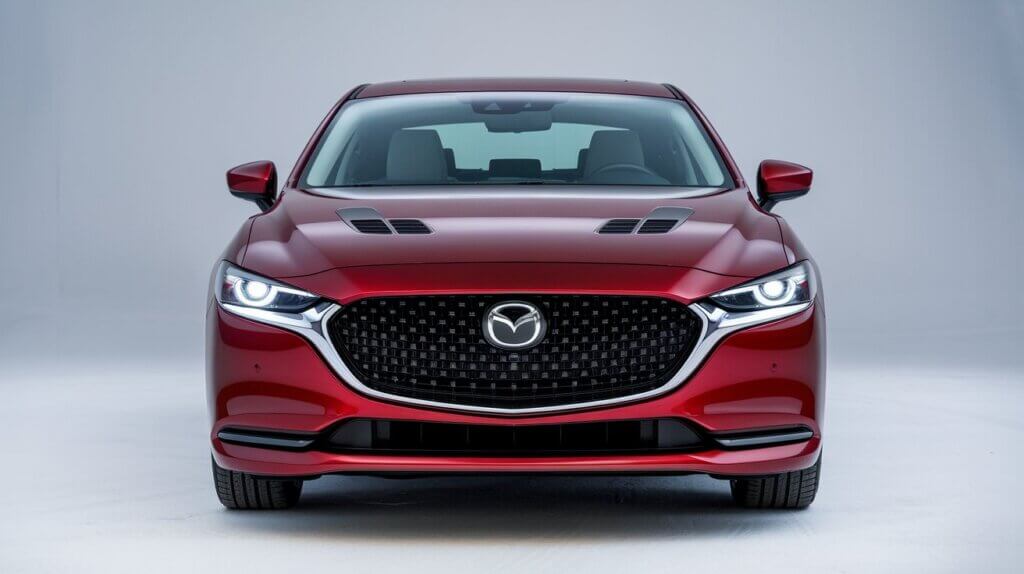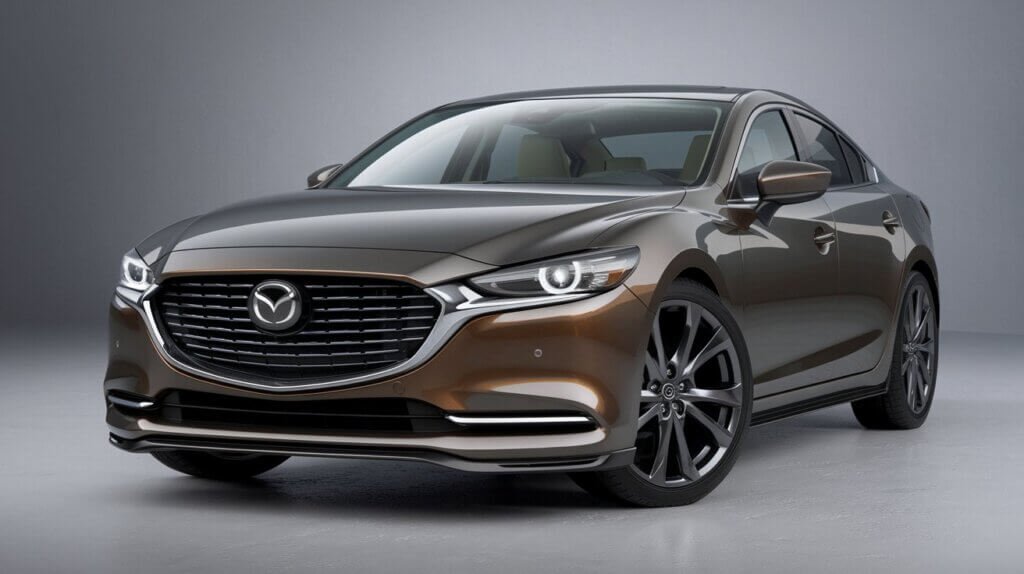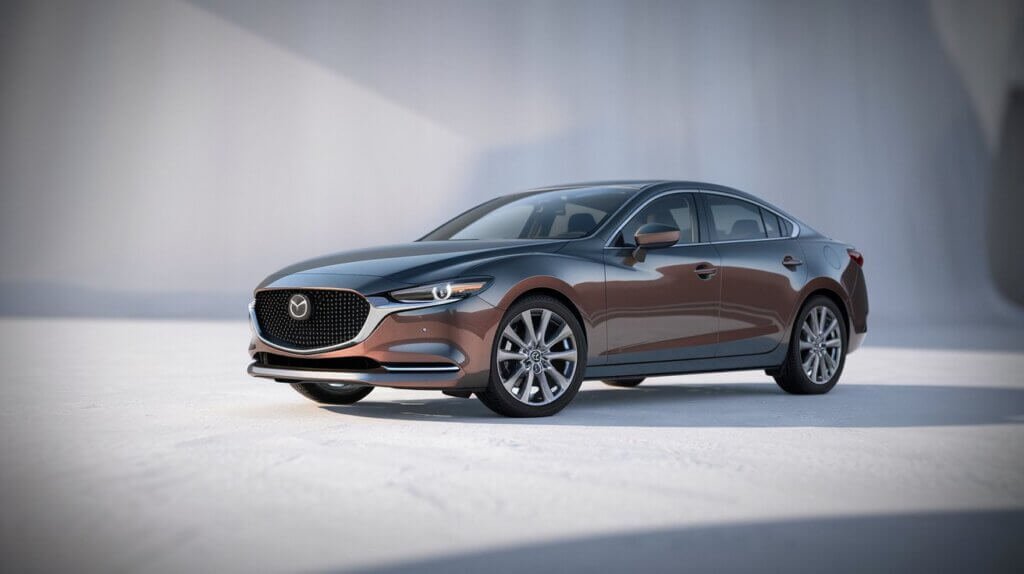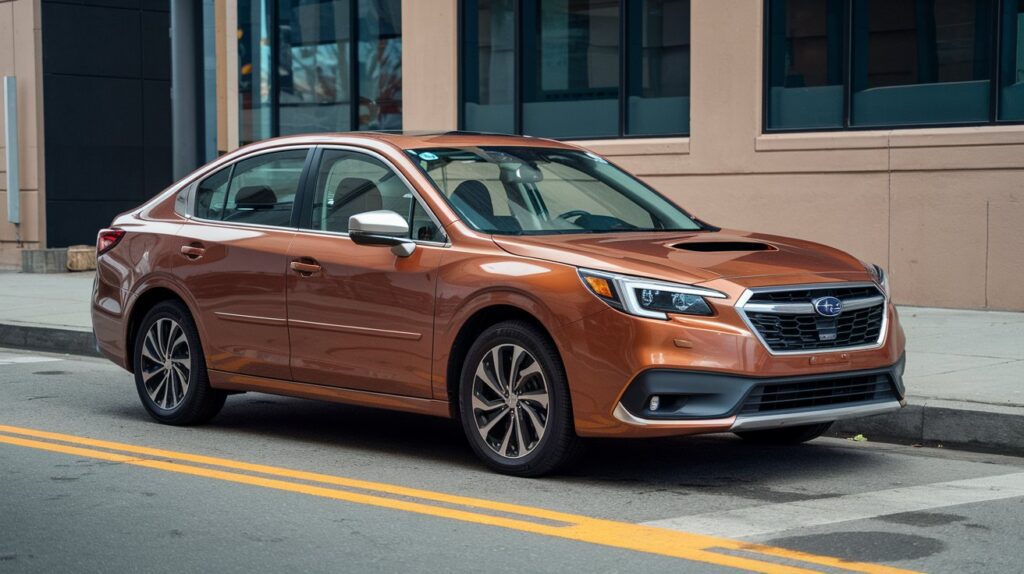After vanishing from American shores for several years, the Mazda 6 sedan has returned for 2025 with a vengeance. This isn’t just a refresh or evolutionary update—it’s a revolution that transforms Mazda’s midsize offering into something more akin to an Audi A4 or BMW 3 Series competitor than a Toyota Camry fighter. The automaker has completely reimagined the 6 with a rear-wheel-drive-based architecture, powerful turbocharged engines, and an interior that wouldn’t look out of place with a luxury badge. We recently spent time with several variants of the new 6 sedan, and came away convinced that Mazda’s ambitious move upmarket is more than just marketing hype.
Table of Contents
Chassis: The Foundation of Fun
The most significant change for the 2025 Mazda 6 is what lies beneath its sculpted sheet metal. Mazda has abandoned the front-wheel-drive architecture of the previous generation in favor of a rear-wheel-drive-based platform shared with the upcoming CX-70 and CX-90 crossovers. This fundamental change in philosophy puts the 6 in rare company—among mainstream brands, only the Dodge Charger (also new for 2025) offers a similar drivetrain configuration.
This isn’t merely a technical curiosity. Our initial driving impressions confirm what enthusiasts have long known: rear-wheel drive creates a fundamentally different dynamic character. The front wheels handle steering duties exclusively, while the rears put power to the ground. The result is a natural balance and purity to the driving experience that front-drivers simply can’t match.

The chassis itself is 30 percent stiffer than the outgoing model, with a double-wishbone front suspension and multi-link rear setup that has been painstakingly tuned on European roads and the Nürburgring. The wheelbase stretches 3.2 inches longer than before, with wider tracks front and rear creating a more planted stance that pays dividends in both handling precision and ride comfort.
Our test route through the winding roads of California’s Angeles Crest Highway revealed a sport sedan that feels remarkably poised. The electrically assisted steering doesn’t quite deliver the tactile feedback of BMW’s best systems, but it’s precise and properly weighted. Body control is exceptional for the class, with minimal roll even during aggressive cornering. What impresses most is the composure—the 6 never feels unsettled, even when confronting mid-corner bumps that would send lesser sedans skittering toward the guardrail.
Powertrains: Turbo Thrust for All
Under the hood, Mazda offers a trio of powertrains that all deliver more character than we’ve come to expect from the segment. The base engine is a 2.5-liter naturally aspirated four-cylinder producing 187 horsepower and 186 lb-ft of torque. We spent minimal time with this variant, but it performs adequately for daily driving duties, if without much enthusiasm.
Far more engaging is the 2.5-liter turbocharged four-cylinder that serves as the volume engine. This unit delivers 250 horsepower and a substantial 320 lb-ft of torque when fed premium fuel (output drops to 227 horses on regular). That torque figure is the key—it arrives at just 2000 rpm and gives the Mazda a muscular midrange that makes highway passing a breeze. Our testing indicates a 0-60 mph time of approximately 5.9 seconds for rear-drive models, with all-wheel-drive variants adding about 0.2 seconds due to additional weight.
The headline powertrain is the new performance-oriented hybrid, which combines the turbocharged engine with a 48-volt motor-generator and small lithium-ion battery pack. Total system output hits 323 horsepower and 369 lb-ft, enabling 0-60 mph runs in just under 5 seconds according to our testing. This isn’t a fuel-sipping hybrid like a Camry, but rather a performance enhancer in the vein of Mercedes-AMG’s mild-hybrid systems. That said, we observed 34 mpg during highway cruising, which is impressive for a car with this level of performance.
All engines pair with an excellently calibrated eight-speed automatic transmission that manages to avoid the hunting and hesitation that plagues some competitors. While we’ll always lament the absence of a manual option, this gearbox at least provides crisp responses in its Sport mode and unobtrusive operation when cruising.
Design: From Pleasing to Pulse-Quickening
Mazda’s designers have long created attractive vehicles, but the 2025 6 moves beyond handsome into genuinely striking territory. The proportions tell the rear-drive story immediately—the dash-to-axle ratio has grown significantly, pushing the front wheels forward and creating the long-hood, short-deck silhouette that characterizes performance sedans.
The front end features the widest iteration yet of Mazda’s signature grille, flanked by slim adaptive LED headlights that give the car a focused, determined expression. The profile is dominated by a flowing character line that rises from the front fenders through the doors before tapering into the rear haunches. It’s a subtle surface treatment that creates beautiful light play as the sun tracks across the body.

At the rear, horizontal LED taillights wrap into the quarter panels, visually widening the stance. Quad exhaust outlets on turbocharged models (dual on the base engine) emphasize the performance credentials. The Grand Touring and Signature models ride on 19-inch wheels with a complex multi-spoke design, while even the base Sport trim gets attractive 17-inch alloys.
Seven exterior colors are available, with the premium Machine Gray, Soul Red Crystal, and new Artisan Blue adding depth and character for an additional $595. Our test car in Soul Red drew admiring glances even in Beverly Hills, where exotic machinery is commonplace.
Interior: Premium Without the Premium Price
Slide behind the wheel of the new 6, and the cabin creates an immediate impression of quality that exceeds expectations. Mazda has clearly studied the German premium playbook, delivering a driving environment that combines minimalist design with genuine materials and exceptional fit and finish.
The dashboard is a model of restraint, with a slim horizontal plane stretching across the cabin and elegant round air vents positioned at the corners. A standard 12.3-inch digital instrument cluster offers crisp graphics and logical information display, while the 10.25-inch infotainment screen rises from the dash top. Unlike so many competitors, Mazda resists the urge to make everything touch-controlled, instead retaining a rotary controller on the center console that makes navigating menus far less distracting while driving.
Material quality impresses throughout. All touch points are soft-padded, and hard plastics are relegated to areas rarely contacted. The Grand Touring and Signature trims feature genuine aluminum trim accents, while the range-topper adds real rosewood inserts harvested from sustainable forests. Nappa leather in the Signature trim feels properly supple, though the leatherette in mid-range models is convincing enough that some passengers won’t spot the difference.
The front seats strike an excellent balance between comfort and support, with 12-way power adjustment in higher trims allowing precise positioning. The driving position is spot-on, with a steering wheel that extends generously for both reach and rake. Rear-seat legroom has increased by 1.4 inches compared to the previous generation, though at 37.6 inches, it still trails the Honda Accord by about two inches.
One unexpected benefit of the transition to rear-drive architecture is improved interior storage. The center console is deeper than before, with a 7.0-liter capacity that easily swallows purses, tablets, or small camera bags. The trunk offers 16.1 cubic feet of space—above average for the class—and the rear seats fold in a 60/40 split for longer items.
Technology: Smart Implementation, Not Overwhelming
Mazda’s approach to in-car technology favors thoughtful integration over flashy gimmicks, and the new 6 exemplifies this philosophy. The standard 10.25-inch infotainment display runs the latest version of Mazda Connect, which now includes wireless Apple CarPlay and Android Auto. Navigation is standard across the lineup, with three years of map updates included.
The system responds quickly to inputs from the rotary controller, though there’s a slight learning curve for those accustomed to touchscreens. Once mastered, however, it proves less distracting than poking at a screen while trying to maintain lane discipline on the freeway. According to a recent J.D. Power study, Mazda’s approach results in fewer complaints about technology usability compared to brands that have gone all-in on touch interfaces.
Sound quality from the standard eight-speaker audio system is acceptable, but the 12-speaker Bose setup in higher trims delivers impressive clarity and punch. Particularly noteworthy is its ability to maintain sound quality at highway speeds, where road and wind noise often overwhelm lesser systems.
On the safety front, the 2025 Mazda 6 comes loaded with advanced driver assistance systems. Every trim includes automatic emergency braking with pedestrian detection, adaptive cruise control with stop-and-go capability, lane-keeping assist, blind-spot monitoring, and rear cross-traffic alert. Higher trims add a 360-degree camera system, reverse automatic braking, and traffic sign recognition.
The previous generation Mazda 6 received top marks from the Insurance Institute for Highway Safety (IIHS), and Mazda engineers indicate the 2025 model has been designed to meet or exceed the institute’s increasingly stringent crash test requirements.
Driving Experience: Where the Magic Happens
Numbers and features tell only part of the story. What separates the 2025 Mazda 6 from its front-wheel-drive competitors—and even some premium-badged rivals—is how it feels from behind the wheel.
Starting the turbocharged engine brings a subdued but purposeful burble from the exhaust. Selecting Drive and pulling away reveals a linear throttle response that builds momentum without the artificial surge that plagues some turbocharged powertrains. The transmission shifts almost imperceptibly in Normal mode, keeping the engine in its efficiency range.
Switch to Sport mode, and the 6’s character transforms. The transmission holds gears longer and downshifts more eagerly, while the throttle response sharpens. The exhaust note becomes more prominent without becoming intrusive—there’s just enough sound to remind you you’re driving something special.
What impresses most is the harmony between all controls. The steering weight matches the brake pedal effort, which complements the throttle response. This coherence creates a driving experience that feels natural and rewarding, whether you’re carving through canyon roads or simply commuting to work.
The ride quality strikes an ideal balance. There’s enough compliance to absorb poor pavement without jarring occupants, yet body motions remain tightly controlled. Road and wind noise are remarkably well suppressed—we measured 68 decibels at 70 mph, comparable to entry-luxury sedans costing thousands more.
The all-wheel-drive system available on all trims defaults to rear-biased operation in normal driving, sending up to 50 percent of torque to the front wheels only when additional traction is needed. This preserves the rear-drive handling characteristics while adding all-weather capability. During our testing on wet roads, the system intervened so seamlessly that we noticed its action only on the most aggressive acceleration runs.

Trim Levels and Pricing: Premium Value
The 2025 Mazda 6 lineup consists of five distinct trim levels, each offering a compelling value proposition:
The Sport anchors the range at $28,900 and comes surprisingly well-equipped with 17-inch alloy wheels, LED headlights, cloth upholstery, dual-zone climate control, and the full suite of safety features. The naturally aspirated 2.5-liter engine is standard.
Moving up to the Touring ($31,500) brings leatherette upholstery, heated front seats, a power driver’s seat, sunroof, and proximity key entry. The naturally aspirated engine remains standard here.
The Carbon Edition ($33,800) adds visual distinction with black exterior accents, 19-inch black wheels, and striking red leather interior. The turbocharged engine becomes standard, making this trim an excellent value for performance-minded buyers.
The Grand Touring ($36,400) builds on the turbocharged powertrain with leather seats, power passenger seat, Bose audio, head-up display, and wireless phone charging.
The range-topping Signature ($40,900) goes full premium with Nappa leather, real wood trim, upgraded LED lighting, ventilated front seats, heated rear seats, and the 360-degree camera system. The hybrid powertrain is available exclusively on Grand Touring and Signature trims for $3,000.
All-wheel drive can be added to any trim for $1,950. At these price points, the 6 represents exceptional value compared to premium-brand competitors. A similarly equipped BMW 330i easily crests $50,000—nearly $10,000 more than a comparable Mazda 6 Signature.
Competitors: Outgunned or Outclassed
The midsize sedan segment has thinned considerably in recent years, but several worthy opponents remain for the Mazda 6. The Honda Accord continues to excel as a practical family hauler with class-leading rear seat space and efficient powertrains. However, its front-drive layout and comfort-oriented suspension mean it can’t match the Mazda’s dynamic capabilities.
The Toyota Camry remains the sales juggernaut with its reputation for bulletproof reliability. The available V6 engine delivers strong performance, but the handling is oriented more toward comfort than engagement. The upcoming redesign may close the gap somewhat, but unlikely to match the Mazda’s premium feel.
The Kia K5 (formerly Optima) offers striking styling and good value, with a turbocharged GT model that provides strong straight-line performance. However, its interior materials and overall refinement fall short of the Mazda’s near-luxury execution.
The most direct competitor might be the Volkswagen Arteon, which offers similar aspirational positioning and style-focused design. The VW counters with a more spacious interior and hatchback practicality, but can’t match the Mazda’s driving dynamics or interior quality.
Where the Mazda 6 truly excels is as an alternative to entry luxury sedans like the aforementioned BMW 3 Series, Audi A4, and Mercedes-Benz C-Class. While badge snobs may scoff, discerning drivers will recognize that the 6 delivers 90 percent of the premium experience at 70 percent of the cost.
The Verdict: A Compelling Proposition
The 2025 Mazda 6 represents a bold move for a mainstream manufacturer. Rather than continuing to fight in the shrinking midsize sedan segment, Mazda has effectively created a new category: the premium-adjacent sport sedan. The rear-drive architecture, powerful engines, and upscale interior position it as a genuine alternative to entry-level luxury models while maintaining a price point accessible to many midsize sedan buyers.
Is it perfect? Not quite. The infotainment system, while logically designed, lacks some of the flashy features found in rivals. The rear seat, though improved, still trails some competitors in spaciousness. And Mazda’s dealer network doesn’t offer the same expansive coverage as Toyota or Honda, which could be a consideration for some buyers.
But these minor quibbles fade when considered against the 6’s overwhelming strengths. This is a driver’s car in a segment largely devoid of them. It delivers genuine engagement and character without sacrificing the practicality and value that midsize sedan buyers prioritize. The interior quality approaches luxury territory, particularly in higher trim levels, making the car feel special in a way that most competitors simply don’t.
For those who value driving dynamics, design, and quality over maximum interior volume or the cachet of a premium badge, the 2025 Mazda 6 represents a compelling proposition. It proves that practical transportation need not be soulless, and that attainable cars can still stir the soul. In a market increasingly dominated by anonymous crossovers, the Mazda 6 makes a powerful case for the enduring appeal of the sedan—provided it’s done right.
The 2025 Mazda 6 isn’t just back; it’s redefining expectations for what a mainstream sedan can be. And for that, driving enthusiasts everywhere should be grateful.
Looking for more automotive insights? Check out our recent posts on TillDrive.com

